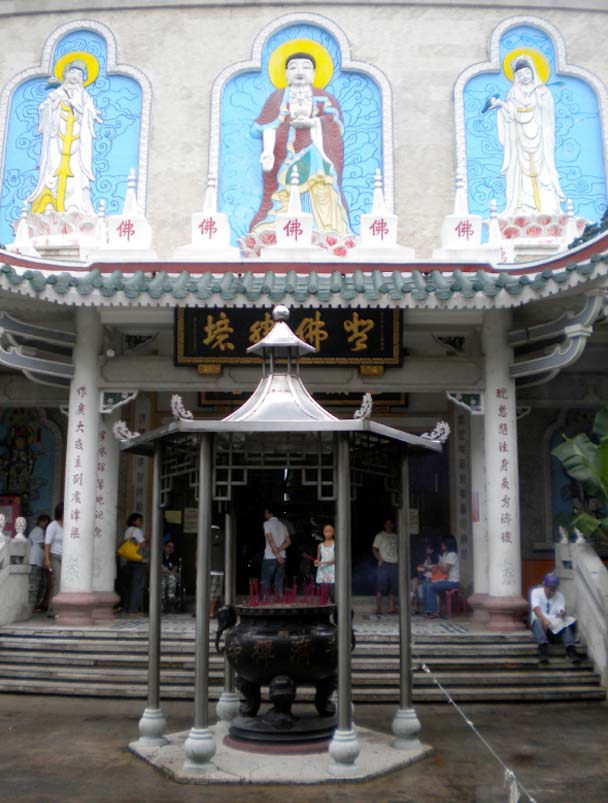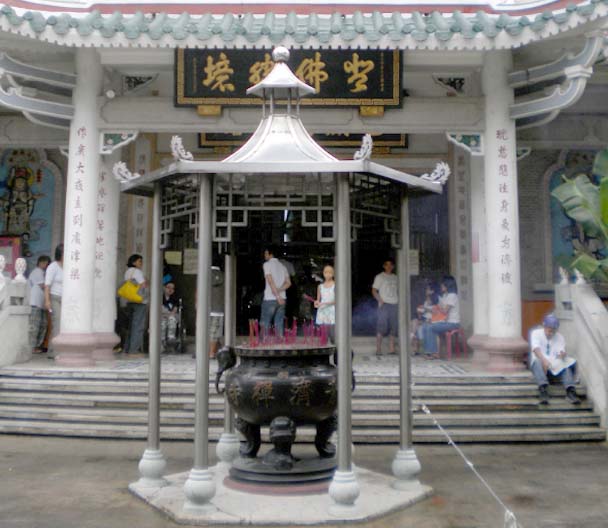Editors Note: This is the 20th of a series about the 36 Chinese Buddhist temples of the Philippines. Much of the information is from a thesis of Venerable Chuanmiao (Hsuan Chuang University, 2008), a Buddhist monk affiliated with the Thousand Buddha Temple in Quezon City.
20. Thousand Buddha Temple (普濟禪寺)
15 Don Jose cor. Maria Clara Streets, Quezon City
Tel.: 742-5556 • 712-4713
The temple was founded by Guangchun (廣純), who became a disciple of Ruijin when the latter was based at the Chengtian Temple (承天寺) in Quanzhou in 1937.
He trained at temples in Jinjiang, Fuzhou and Hong Kong until Ruijin asked him to go to Manila in 1957 to join the monastic community at Seng Guan Temple. He spent 20 years in Seng Guan, and in 1976 purchased land in Quezon City, founding this temple the following year.
The temple developed its facilities over the next 10 years and attracted many devotees who found its location in Quezon City a strong alternative to Seng Guan and other temples in downtown Manila.
Guangchun has both male and female disciples from China, Taiwan, and the Philippines, thus the presence of both male and female monastics in the temple. In 1994, Guangchun also founded the Philippine Buddhacare Academy across the street.

Main buildings. The first building to be constructed in 1980 enshrines an image of Vairocana Buddha flanked by 1,000 small images of Guanyin, thus the temple’s English name. The ground floor is the dining hall and shrine to the 18 arhats (lohan) of Chinese Buddhism, the Medicine Buddha and the Thousand Hands Thousand Eyes Guanyin.
The temple’s main inspiration is Mt. Putuo Guanyin, thus, the Chinese name takes after the main temple on Mt. Putuo (普陀山). The second building is dedicated to Guanyin and where chanting services are held. An ancestral hall is on the ground floor, and monastics’ quarters are on the third floor. The third and most recent building is a three-storey columbary, with individual stupas on the roof.
The temple often uses facilities at the Philippine Buddhacare Academy, especially for its charitable activities.
Leadership and primary activities. Until his death in December 2010, Guangchun led the temple assisted by his Dharma sister, the nun Guangxue (廣學), who is now in charge.
Regular services are held Sundays and all the major feast days, especially those for the dead during the Qingming and Yulanben festivals. This is partly due to the presence of the columbary and the devotees’ desire to offer prayers for the dead.
The temple is also near several funeral homes, so the monastics are kept busy responding to requests of Chinese families for chanting services there.
Lay devotees are quite active. They operate a medical and dental clinic twice a month, Sunday school, children’s summer camp, and seasonal charitable activities. A womens’ group meets monthly for chanting, fellowship, and organization of activities. Lectures and discussion groups are held occasionally, especially when there are visiting monastics from other countries. — First published in Tulay Fortnightly, Chinese-Filipino Digest 25, no. 23 (May 7-20, 2013): 14.





